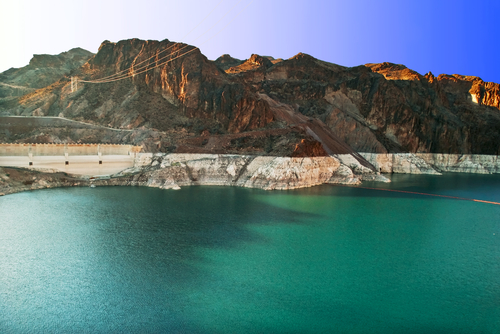Why would anyone want to export that fiasco to another environmental issue? It's academic. Sometimes academic is obviously a good thing; basic research, for example. And sometimes 'academic' connotes 'out of touch with reality', like people in the humanities who try and argue that communism really works, it's just that no one has really tried it.
Cap-and-trade for water is that second kind of academic. Lake Mead, on the 1,440-mile-long Colorado River, is America's largest water reservoir. As the population of the U.S. has grown, it sometimes happens that in drought years people and agriculture consume more water than flows down the river. An undergraduate at Quest University Canada calculated the water in Lake Mead and wondered what might happen if the Colorado River ran short of water in the next 20 years. The solution he derived with postdoctoral researcher Dr. Rich Wildman was to take a cap-and-trade concept that doesn't work with emissions and use it for water, where it is already controversial overseas.

Lake Mead near Hoover Dam. You can't afford to live there. Under a cap-and-trade plan, you won't even be able to afford to drink water from there. Photo: Shutterstock
A layer of expensive government bureaucracy to regulate which poor people can have water and which cannot? They claim it "builds on the success" of a similar plan in Australia but it's an odd marketing pitch to Americans, who claim to be against bundling mortgages but are supposed to embrace bundling water contracts. Some companies in Australia claim they will yield a 15% return on investments for the rich people buying their water funds. How is that a good thing for poor people in the US?
Activists always paint a rosy picture for the costs of cap and trade schemes (with emissions, supposedly gas $2 a week higher, energy $4 a week higher, etc.) but these are the same people who shrieked about how terrific biofuels were for all of the 1990s. There was no science to biofuel claims then, just hope that the miracle of capitalism would make it work if the government would pick winners and losers in the private sector and slap on a bunch of regulations. $10 billion in subsidies and mandates later and all poor people got from biofuels was expensive corn and even higher environmental footprint for gasoline. It won't be any different for water - even worse, it isn't needed for water, it is hypothetical.
Their template was the Murray-Darling Basin interstate water trading system in Australia - what they call successful, and so do lots of people who don't live there. Instead, the people who live there feel like they are being exploited for financial gain - and they are not buying that supposed efficiency improvements won't lead to compulsory cuts in water when fat contracts are not met.
The U.S. Bureau of Reclamation is in the impact analysis business and their mission is to present policymakers with options, including should shortfalls in the Colorado river be persistent enough to be a concern - and that was the motivation for the new model. That's all well and good but cap and trade is only considered a success by Treehugger and their ilk - and then mostly because they don't care about the costs for poor people.
Dr. James Hansen, who runs the NASA Goddard Institute for Space Studies in New York, is certainly the foremost climate scientist in the world, and he calls cap-and-trade a "path focused on corporate greed" because it is obviously a hidden tax that impacts the poor the most. It's certainly not going to be a better solution for water, which is vital to all life on the planet.
Citation: Richard A. Wildman Jr., Noelani A. Forde, 'Management of Water Shortage in the Colorado River Basin: Evaluating Current Policy and the Viability of Interstate Water Trading', Journal of the American Water Resources Association, May 2012, DOI: 10.1111/j.1752-1688.2012.00665.x





Comments